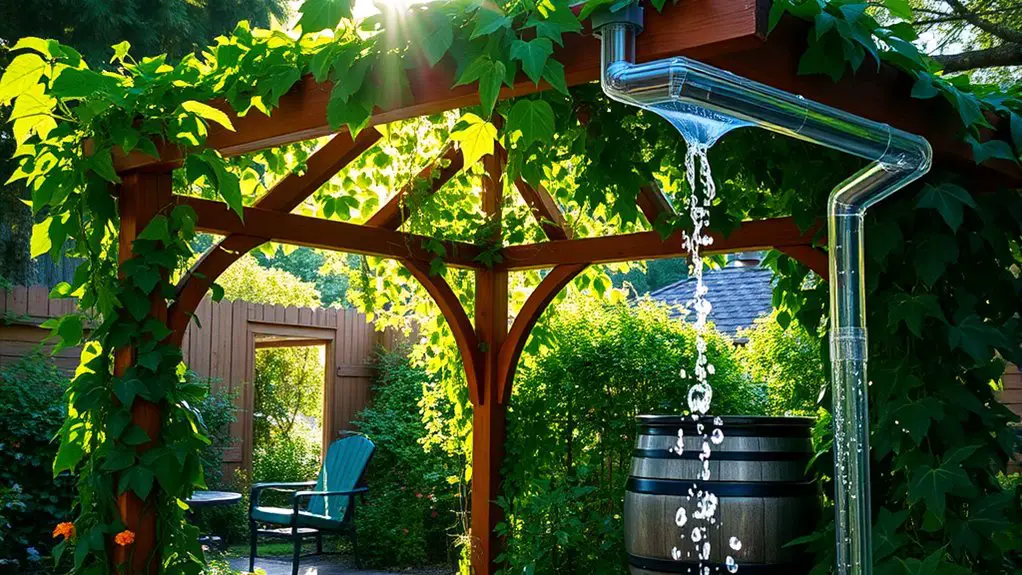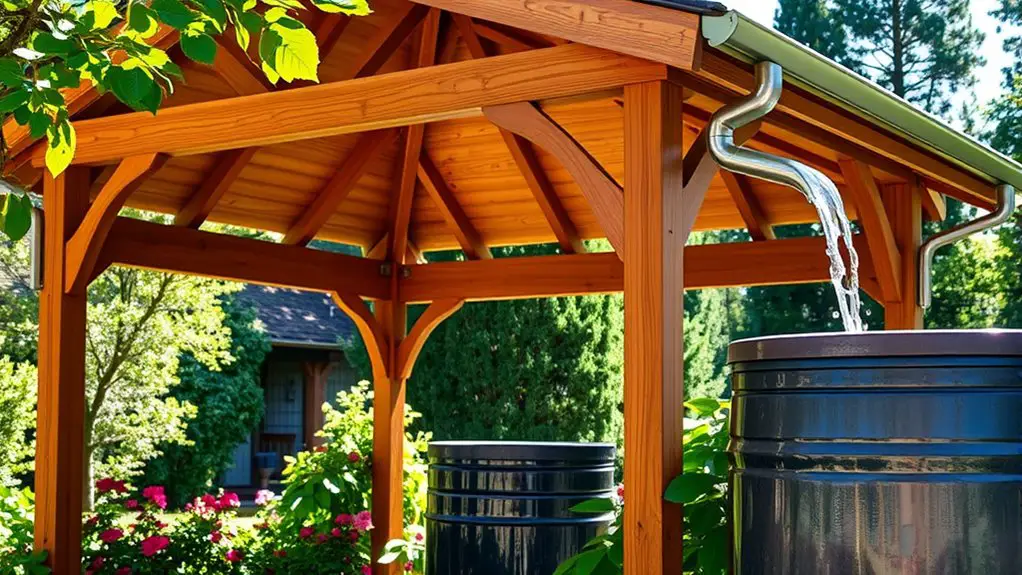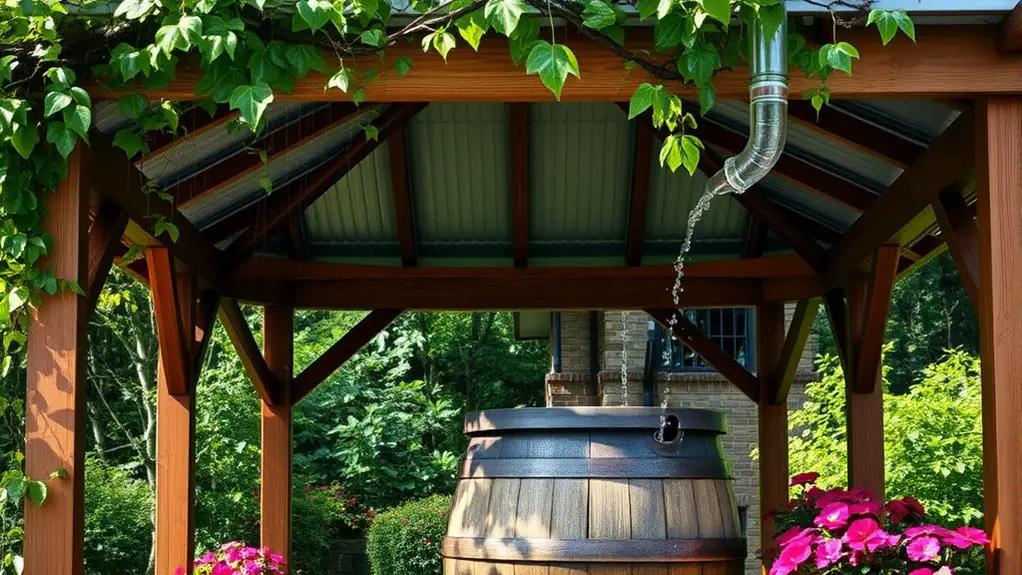To integrate a rainwater collection system into your gazebo, start by evaluating the roof’s slope and ensuring gutters align with drainage lines for ideal runoff. Choose durable materials like metal for gutters and review system types, selecting between passive or active options based on your needs. Position a storage tank close to the gazebo for efficiency and monitor maintenance. This setup not only enhances sustainability but also supports your water needs. Explore more to enhance your design.
Assessing Your Gazebo’s Design for Rainwater Collection

When you consider integrating a rainwater collection system into your gazebo, analyzing its design is essential to guarantee ideal functionality. Start by evaluating the roof slope; a steeper slope enhances water flow, reducing the risk of pooling. Next, focus on gutter placement. Properly positioned gutters capture runoff effectively, guiding water toward your storage system. Make sure they’re aligned with the roof’s natural drainage lines to maximize efficiency.
Additionally, consider the materials used for both the roof and gutters; sustainable options like metal or eco-friendly composites can enhance durability and minimize maintenance. Remember to account for the gazebo’s overall aesthetic while making sure that these components work together seamlessly.
Choosing the Right Rainwater Collection System
How can you determine the best rainwater collection system for your gazebo? Start by evaluating the system types available. You can choose between passive systems, which require minimal maintenance, and active systems that utilize pumps for efficiency. Each has its pros and cons, depending on your needs for water volume and ease of use.
Next, consider material options. Common choices include PVC, metal, and recycled materials. PVC is lightweight and cost-effective, while metals like aluminum offer durability and longevity. Recycled options appeal to those focused on sustainability, often providing excellent performance without compromising environmental values.
Think about your gazebo’s design and aesthetics, too. The right system should complement your space while effectively collecting rainwater. By analyzing system types and material options, you’ll find a solution that meets your needs and supports your commitment to sustainable living.
Installing Gutters and Downspouts

After selecting the right rainwater collection system for your gazebo, the next step involves installing gutters and downspouts to channel the collected water efficiently. Proper installation is essential for maximizing water capture and minimizing waste. Here’s how to proceed:
- Choose the Right Gutter Materials: Opt for durable materials like aluminum or vinyl that resist corrosion and offer longevity.
- Determine Downspout Placement: Position downspouts strategically to direct water away from the gazebo’s foundation. Ideally, place them at corners or along sloped areas for best drainage.
- Install a Slope: Make sure your gutters have a slight slope (about 1/4 inch per 10 feet) towards the downspouts, facilitating smooth water flow and preventing stagnation.
Setting Up a Storage Tank
To guarantee your rainwater collection system functions effectively, it’s crucial to set up a storage tank that meets your specific needs. First, consider the materials for your storage tank. Options like polyethylene, fiberglass, or concrete each have benefits, such as durability and resistance to UV light. Selecting the right material can greatly impact the longevity of your system.
Next, think about the tank location. Ideally, place it close to your gazebo to minimize the distance water needs to travel, reducing potential contamination and guaranteeing easy access for maintenance. Confirm the location is level and considers local regulations regarding water collection systems.
Lastly, calculate your expected rainwater yield to choose an appropriately sized tank. Balancing tank capacity with your gazebo’s usage will provide a sustainable solution, allowing you more freedom in water management while promoting eco-conscious living.
Maintaining Your Rainwater Collection System

While maintaining your rainwater collection system may seem intimidating, regular upkeep is essential to secure peak performance and longevity. By conducting routine inspections, you can identify common issues before they escalate, securing a sustainable water source for your gazebo.
Here are three key maintenance tasks to keep in mind:
- Check Filters and Screens: Regularly clean or replace filters and screens to prevent debris buildup, which can hinder water flow.
- Inspect Storage Tanks: Look for any signs of leaks or corrosion in your storage tanks. Addressing these issues early can save you from costly repairs later.
- Monitor Water Quality: Periodically test your collected rainwater for contaminants. This secures that your water remains safe and usable for irrigation or other non-potable applications.
Frequently Asked Questions
Can I Collect Rainwater in a Portable Gazebo?
Yes, you can collect rainwater in a portable gazebo. Its benefits include mobility and ease of setup, while rainwater storage systems can enhance sustainability, allowing you to utilize natural resources efficiently, promoting freedom from conventional water sources.
Are There Local Regulations for Rainwater Collection Systems?
You should research local guidelines regarding rainwater collection systems. Compliance requirements can vary considerably by region, so understanding these regulations is essential for ensuring your sustainable practices align with legal standards and allow you freedom in implementation.
What Types of Plants Benefit From Rainwater Collection?
Imagine a thriving oasis in your garden—native plants and drought-resistant species flourish with collected rainwater. They not only conserve resources but also create a sustainable environment, giving you the freedom to nurture nature responsibly.
How Often Should I Test Collected Rainwater Quality?
You should test collected rainwater quality regularly, ideally every month, to guarantee it meets water testing quality standards. This proactive approach helps maintain safety and sustainability, empowering you to use your collected resource confidently and responsibly.
Can Rainwater Collection Systems Attract Pests or Insects?
Think of a garden; without pest prevention, weeds thrive. Similarly, rainwater systems can attract insects. Implementing insect control measures, like screens or proper maintenance, guarantees your collection remains a sustainable source without unwanted guests.

